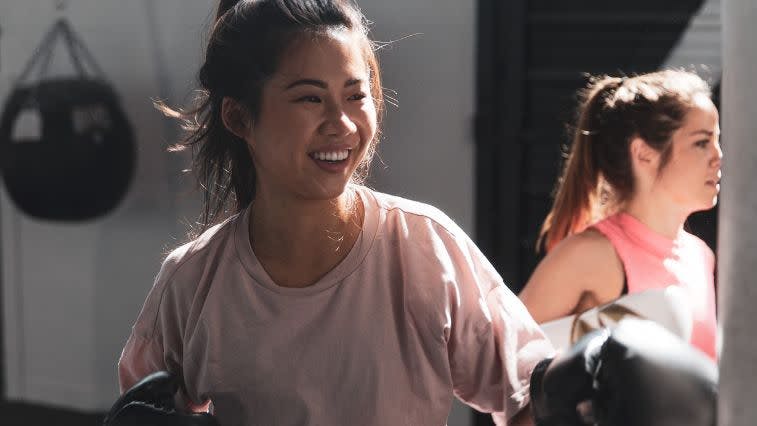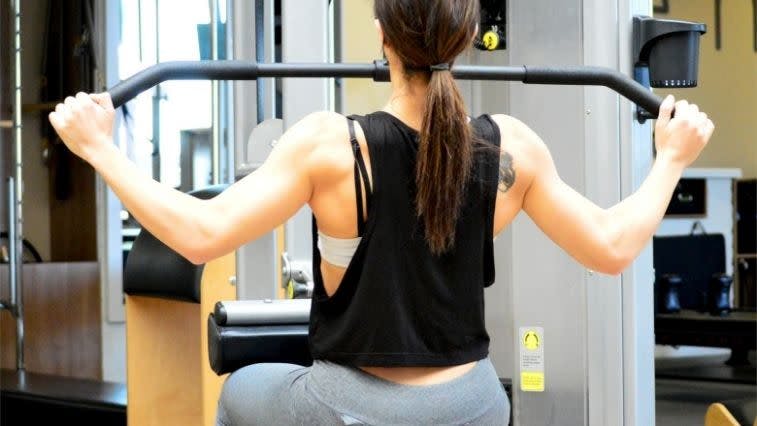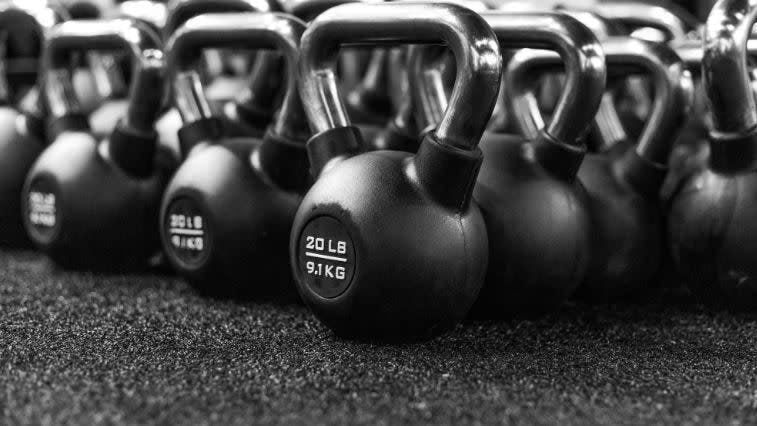What You Need to Know Before You Start Working Out at the Gym
Plus three pitfalls to avoid
Our content strives to support, inform, and motivate you to meet your health goals. We want to be your trusted source of expert- and science-backed info dispensed in simple, actionable ways. Read our Editorial Guidelines.
You’re serious about starting your fitness routine. You’ve picked a gym to visit. But what should you do first? How long will it take to look more “fit”?
It’s not about training to be a model or triathlete, though. It’s your journey, run at your pace toward a healthier, more disciplined mind and body — whatever that means for you.
If exercising is new territory to you, it can be easy to feel intimidated or even hopeless at the outset. Working out at the gym for the first time would make anyone feel anxious. Weighted plates, kettlebells, and some of the weight machines look like medieval torture devices; the wall-to-wall mirrors may make you want to hide; the grunting dudes and super fit ladies in lululemon wearing make-up look like they belong; not knowing where to find a clean gym towel… it’s a lot to unpack.
We asked three certified fitness experts to share the moves and attitudes to practice for immediate and long-term success for working out at the gym.
Start With What You’ll Enjoy
Renee Dunn, a certified personal trainer and nutritionist in Washington, D.C., says that the best way to start working out at the gym is to pick a style of movement that you can keep up. “At the end of the day, if you don’t find something that you enjoy to move your body, you’re not going to stick with it.”
Solo or Group — Your Choice

Should you join a group fitness class and let the instructor determine your workout, should you meet a friend or two at the gym for a sweat session, or should you go at it alone? Our experts agree that solo or group workouts are a matter of preference.
Ryan Glatt, CPT, NBC-HWC, senior brain health coach and director of the FitBrain Program at Pacific Neuroscience Institute in Santa Monica, CA, says group settings might work out better for people who feel they need external accountability. Group routines might beef up the intensity of your workouts, he says, because you might be more motivated to push yourself harder when you have other people to do it with.
If you’re more self-motivated, you may prefer to exercise on your own. And exercising alone can work for self-pacing and building the stamina and endurance to be able to increase the intensity and last longer. This takes time, so be patient, and remember that consistency will get you there.
Lauren Polovoy, a certified trainer, coach, and nutritionist, suggests doing a little homework before starting a group exercise program at the gym. “I would ask questions ahead of time: How many movements are involved? If I’m unfamiliar with something, is there a way to bridge it?”
How Long Should Your Workout Be?
Dunn believes that newbies should not focus on the amount of time they spend in the gym. Instead, focus on moving with good form and increasing repetitions, intensity and/or weights over time. This is called progressive overload.
“It’s week one for me and I'm just getting started,” says Dunn. “I get really tired after two sets of 10 bodyweight squats. The next week, I want to try to do three sets of 10. Or I want to do two sets of 10 with the weight in my hand. I would think about it as trying to move well for as long as I can and, when I hit fatigue, stopping. I'm trying to increase that over time.”
Dunn says this approach works better for beginners than setting a timer and following it rigidly.
It’s all about building habits. Each little win can translate to increased strength and morale, which will motivate you to keep working out.
Your “Off Days”
What about the days away from the gym? You should definitely take them. Dunn recommends that you move every day for at least 30 to 60 minutes. Going for a walk, playing with your kids, cleaning the house… all that counts in her book.
Science backs her up, too. A 2022 study reported that just a few minutes of daily activities may help prolong life. Another 2023 study found that 5-minute walks can help lower blood pressure and regulate blood sugar.
Strength Training Is Important for Everyone

Everyone — no matter what your age, gender, health condition, or fitness level — can benefit from strength training. As we get older, we start losing muscle mass if we don’t stay active and use our muscles, so it’s important to get into the habit of strength training now to preserve muscle mass, bone density, and longevity.
Beginners who strength train at the gym actually have a bit of an advantage because they can use the weight machines to assist with learning proper exercise form, increasing range of motion, and controlling the amount of weight they lift while avoiding injury. Most weight machines require the user to select the amount of weighted plates they lift with a pin; if you add too much weight, you simply won’t be able to complete the full repetition of the exercise. If you were to do that with a dumbbell or kettlebell, you could risk a strain or muscle pull if you yank, arch, or push past a safe range of motion to complete the rep.
Dunn teaches her new clients to kick off with simple movements. Leave one-legged squats, heavy weights, or balancing on a post for later, once you’ve established your exercise habits.
Foundational motions like two-legged squats, hip hinges (used, for example, in Romanian deadlifts), and planks are, “the best thing you can do for your body,” she says.
Complete planks using your body weight, but if you’d like to add resistance to squats or Romanian deadlifts, here are some ways you can do them with machine assistance at the gym:
Start with light weight or no weight at all just to get used to the machines. You can even do the first set of eight to 10 repetitions without weight and then add weight for the next set.
Dunn also recommends anything to help with shoulder stability, like push-ups (modify these on your knees or while standing and pushing off a wall, if needed) or shoulder presses (with light weights). Pull in your abdominal muscles and keep your back and hips straight and still (this is called bracing your core) while you push the weights up and slowly lower them back to the starting position.
These four kinds of movements will help you build a solid foundation of working through all your planes of motion, Dunn explains. They’ll help you build strength.
Get Expert Help: In-Person or Online Personal Training
Hiring a certified personal trainer to work with at the gym gives you access to a fitness expert who can help you set goals, design a customized training program for you, show you exercise modifications, and tweak the plan based on how you respond to it. Glatt says that in-person training can provide certain cueing strategies and incorporate equipment that might not otherwise be available.
That said, in-person personal training tends to be more costly than online personal training. Rates can vary based on location and whether the trainer works independently or for the gym, but the average cost in the U.S. is $65 per hour. If you were to see your in-person personal trainer only once a week for an hour, that would cost you $260 a month. In contrast, online personal training with Kickoff costs $95 a month.
In addition to cost savings, online training lets you choose the time you work out, which may help you build consistency. You would also have access to trainers that may not be local, opening you to a great pool of expertise. You can basically cherry-pick the best online personal trainer for you.
Fitness professionals understand that some people get nervous about trying a gym for the first time because they might not fit in. “It’s important to remember that [personal trainers] are here for you, and you deserve to be there just as much as anybody else,” says Dunn. “And if you go to a gym or have a coach that makes you feel otherwise, that’s not the right gym for you.”
What Should You Avoid at The Gym?

Maybe you’re anxious about going to the gym because you’re afraid of messing up and looking out of place. Just remember that you probably felt that way in the past about something that, with practice, is a no-brainer for you now. Try not to compare yourself to others who may be further along in their fitness journeys. Here’s a list of other things to avoid as you start working outs at a gym.
Exercising with improper form
Improper movement patterns carry risks such as swelling, soreness, and decreased range of motion. They can also set you up for injury. If you’re not sure how to do a move, consider working out with a personal trainer who can watch you move and help you with modifications or corrections. If you can’t afford a trainer, find trusted sources of fitness content (like the blog you’re reading, wink) like certified personal trainers, physical therapists, and certified movement specialists and watch their how-to videos on Youtube or TikTok.
The Kickoff app also has workout videos that show you exactly what and how to do moves, and your trainer will assign the workouts that are most effective for your level and goals.
Copying influencers
Social media can be a powerful motivator for fitness, but it can tempt you to try moves you may not be ready for yet, Dunn warns.
She’s had clients who wanted to imitate an influencer’s workout to achieve a certain physique. “It’s really important to be disciplined and consistent with whatever level you’re at,” advises Dunn.
Doing the same workout on repeat
As a beginner, your body will likely respond more quickly to training stimulus and you might see results more quickly than someone with years of workout experience. For all levels, variety and working at different intensities and volume (total training amount) is key to keep seeing results.
For example, high-impact cardio routines such as high-intensity interval training (HIIT) aren’t always an ideal regimen for starters. An occasional high-intensity class may work but trying it every day is: “a great way to burn yourself into the ground,” says Dunn. Try HIIT once a week or once every other week, and make sure to focus on strength training and steady-state (or moderate) cardio efforts.
The Bottom Line
“There's a difference between just working out to burn calories and being tired versus working out to feel stronger and healthier and progressing,” says Dunn.
As you head to the gym for the first time, remember that everybody starts somewhere. Your willingness to try and be coachable is the most important equipment you need. If you’d like an accountability partner and expert trainer that you can work out with at the gym (or at home), sign up for a free consultation with a personal trainer today.